Landscape Performance for Coordinated Development of Rural Communities & Small-Towns Based on “Ecological Priority and All-Area Integrated Development”: Six Case Studies in East China’s Zhejiang Province
Abstract
1. Introduction
1.1. Research Background
1.1.1. The Focus of Rural Development in the Current China Context
1.1.2. Policy Guidance on Rural Construction Development of China over the Last Decade
1.1.3. Research Brief on Rural Development of China over the Last Decade
2. Case Study Overview
2.1. Overview of the Cases
2.2. The Coordinated Development of Villages and Towns from the Perspective of All-Area Integrated Development
2.3. Coordinated Development of Villages and Towns in the Siming Mountainous Area of Yuyao, Zhejiang
3. Methodology
3.1. Introduction of Research Methods
3.1.1. Analytic Hierarchy Process (AHP)
3.1.2. Fuzzy Comprehensive Evaluation Method (FCE)
3.2. Research Ideas and Methods
3.3. Development of the New Comprehensive Evaluation System
3.3.1. Overview of Existing Evaluation Systems
3.3.2. Building of New Comprehensive Evaluation Systems
4. Case Study Results
4.1. Case Study 1: Landscape Implementation for Shilin Village
4.2. Case Study 2: Small Town Remediation Planning Project—Luting Township Market Town
4.3. Case Study 3: Village Planning Project—Hengkantou Village
4.4. Case Study 4: Tourism Planning Project—Along the Ring of Siming Lake
4.5. Case Study 5: Concept Planning of Tourism Development in Dalan Town (2015)
4.6. Case Study 6: Lubu Town’s Overall Tourism Development Plan (2017)
4.7. Comparative Study and Comprehensive Analysis for Key Findings
4.7.1. Findings for Ecological Priority
4.7.2. Findings for All-Area Integrated Development (Analysis of Parking Facilities and Leisure Facilities Indicator)
5. Conclusions
Author Contributions
Funding
Acknowledgments
Conflicts of Interest
References
- National New Urbanization Planning; Chinese Government: Beijing, China, 2019. Available online: http://www.gov.cn/zhengce/2014-03/16/content_2640075.htm (accessed on 26 March 2019).
- Beautiful Rural Construction Evaluation GB/T 37072-2018; National Market Supervision and Management Association China National Standardization Administration: Beijing, China, 2019. Available online: http://www.gb688.cn/bzgk/gb/std_list?p.p1=0&p.p90=circulation_date&p.p91=desc&p.p2=%E7%BE%8E%E4%B8%BD%E4%B9%A1%E6%9D%91 (accessed on 26 March 2019).
- Three-Year Action Plan for Rural Residential Environment Improvement; Office of the Central Committee of the Communist Party of China, General Office of the State Council: Beijing, China, 2018. Available online: http://www.gov.cn/zhengce/2018-02/05/content_5264056.htm (accessed on 26 March 2019).
- Strategic Planning for Rural Revitalization 2018-2022; Chinese Government: Beijing, China, 2018. Available online: http://www.gov.cn/zhengce/2018-09/26/content_5325534.htm (accessed on 26 March 2019).
- Wang, Z.Y.; Chang, J.G. The Evolution Trend and Perspective of Rural Construction in China. Architect. Cult. 2019, 3, 81–84. [Google Scholar]
- Yao, L.; Liu, Y.T. A Review on the Type and Model of Rural Development. South Architect. 2004, 2, 44–50. [Google Scholar]
- Interim Measures for the Assessment and Acceptance of Environmental Comprehensive Improvement Actions in Small Towns in Zhejiang Province Zhejiang Small Town Environmental Comprehensive; Improvement Action Leading Group Office: Hangzhou, China, 2016.
- Zhao, K. Research on Ecological Coupling Theory and Method of Urban and Rural Spatial Planning; Chongqing University: Chongqing, China, 2007; pp. 139–141. [Google Scholar]
- Saaty, T.L. How to Make a Decision: The analytic hierarchy process. Eur. J. Oper. Res. 1990, 48, 9–26. [Google Scholar] [CrossRef]
- Zadeh, L.A. Fuzzy sets. Inf. Control 1965, 8, 338–353. [Google Scholar] [CrossRef]
- Urban Master Plan Implementation Assessment Method (Trial); Ministry of Housing and Urban-Rural Development Construction Regulations: Beijing, China, 2009.
- Zhou, Y.N.; Jiang, T. International Experience and Enlightenment of UK Annual Plan Implementation Assessment. Int. Urban Plan. 2016, 3, 98–104. [Google Scholar]
- Murakami, S.; Kawakubo, S.; Asami, Y.; Ikaga, T.; Yamaguchi, N.; Kaburagi, S. Development of a comprehensive city assessment tool: CASBEE-City. Build. Res. Inf. 2011, 39, 195–210. [Google Scholar] [CrossRef]
- American “Landscape Performance” Evaluation Index System. Available online: https://www.landscapeperformance.org/ (accessed on 26 March 2019).
- Taner, R.O. Social value of urban landscapes: Performance study lessons from two iconic Texas projects. Landsc. Architect. Fron. 2016, 4, 12–29. [Google Scholar]
- Taner, R.O.; Stewart, D. Assessing economic performance of landscape architecture projects: Lessons learned from Texas case studies. Landsc. Archit. 2015, 1, 70–86. [Google Scholar]
- Yu, X.J.; Guo, W.M. AHP evaluation of landscape quality in rural cultural square. J. Nanjing Univ. Arts 2018, 2018, 160–164. [Google Scholar]
- Du, D.; Pang, Q.H. Modern Comprehensive Evaluation Method and Case Selection; Tsinghua University Press: Beijing, China, 2015. [Google Scholar]
- Wang, Z.; Yang, B.; Li, S.; Binder, C. Economic Benefits: Metrics and Methods for Landscape Performance Assessment. Sustainability 2016, 8, 424. [Google Scholar] [CrossRef]
- Zhao, T.; Zhao, Y. Landscape Improvement Planning and Design of Shilin Village; Shanghai Tongda Planning and Architectural Design Co., Ltd.: Yuyao, China, 2014. [Google Scholar]
- Zhao, T.; Zhao, Y. Comprehensive Planning and Improvement Plan for the Town of Luting; Shanghai Tongda Planning and Architectural Design Co., Ltd.: Shanghai, China, 2017. [Google Scholar]
- Zhao, T.; Zhao, Y. Rectification Planning and Design of Beautiful Rural Boutique Village in Hengkantou Village; Shanghai Tongda Planning and Architectural Design Co., Ltd.: Shanghai, China, 2013. [Google Scholar]
- Zhao, T.; Zhao, Y. Implementation Plan for the Development of the Siming Lake; Shanghai Tongda Planning and Architectural Design Co., Ltd.: Shanghai, China, 2015. [Google Scholar]
- Zhao, T.; Zhao, Y. Dalan Town Tourism Development Concept Plan; Shanghai Xilian Urban Planning and Architectural Design Co., Ltd.: Shanghai, China, 2015. [Google Scholar]
- Zhao, T.; Zhao, Y. Lubu Town’s Overall Tourism Development Special Plan; Shanghai Tongda Planning and Architectural Design Co., Ltd.: Shanghai, China, 2017. [Google Scholar]
- Zhao, T.; Zhao, Y.; Li, M. Landscape Performance for Coordinated Development of Rural Communities Small-Towns Based on Ecological Priority and All-Area Integrated Development Guideline: A Case Study in East Zhejiang, China. In Proceedings of the 2019 Annual Conference of the Council of Educators in Landscape Architecture, Sacramento, CA, USA, 6–9 March 2019. [Google Scholar]
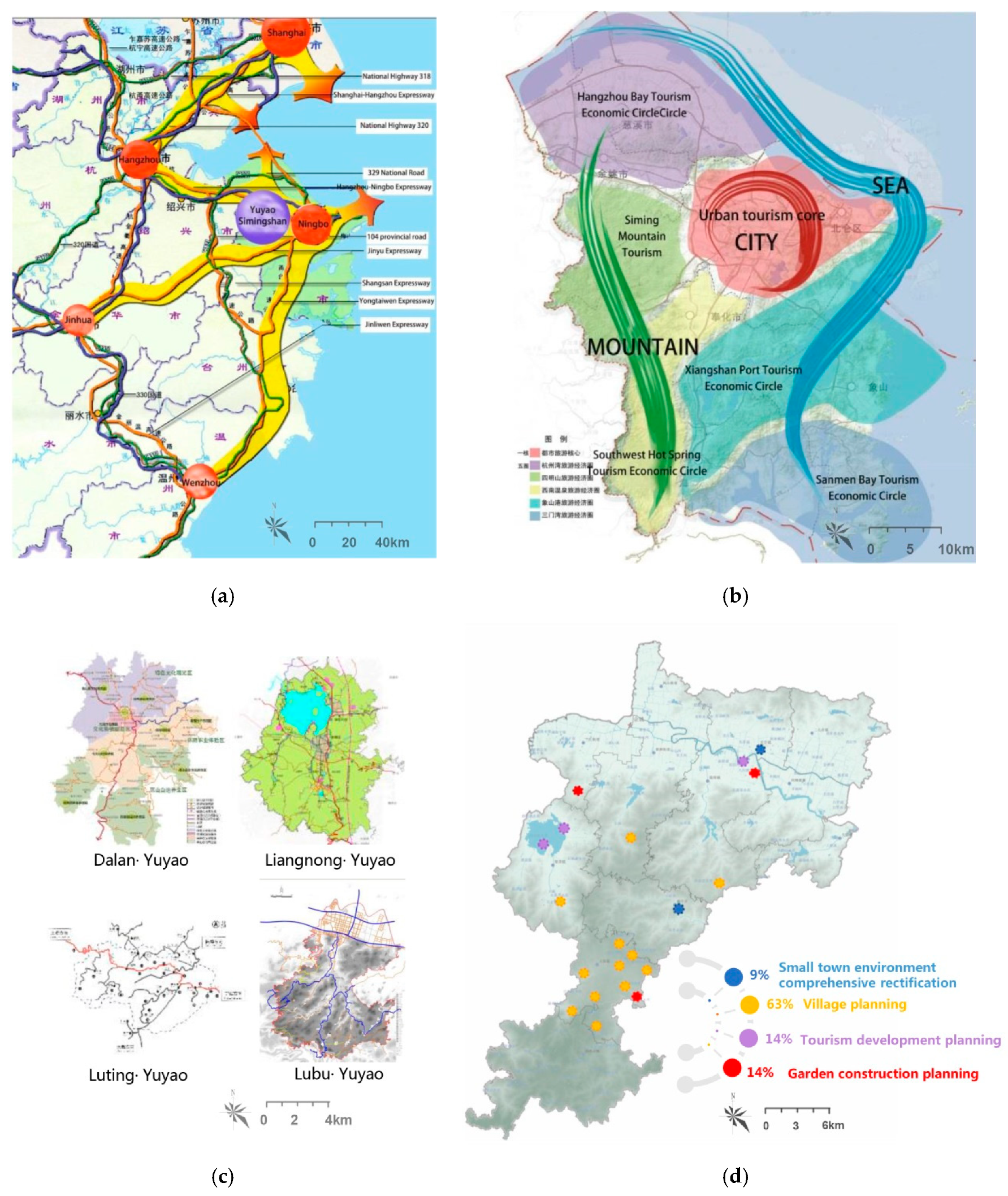
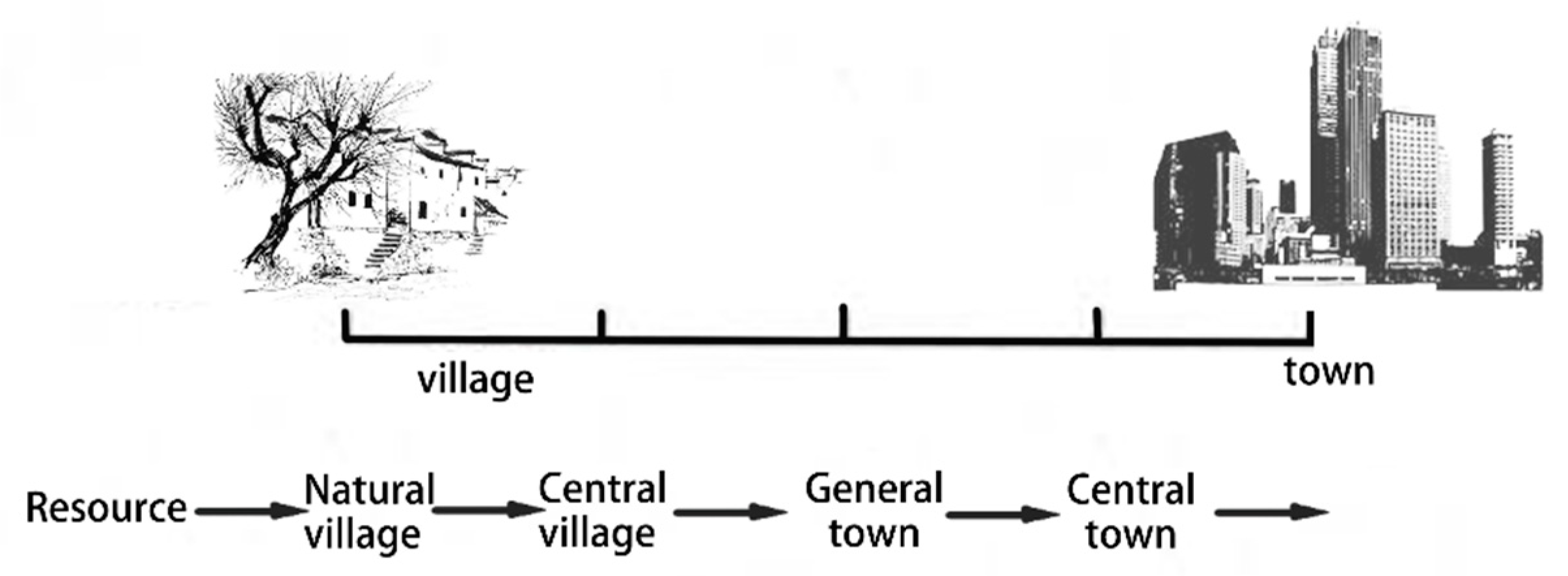



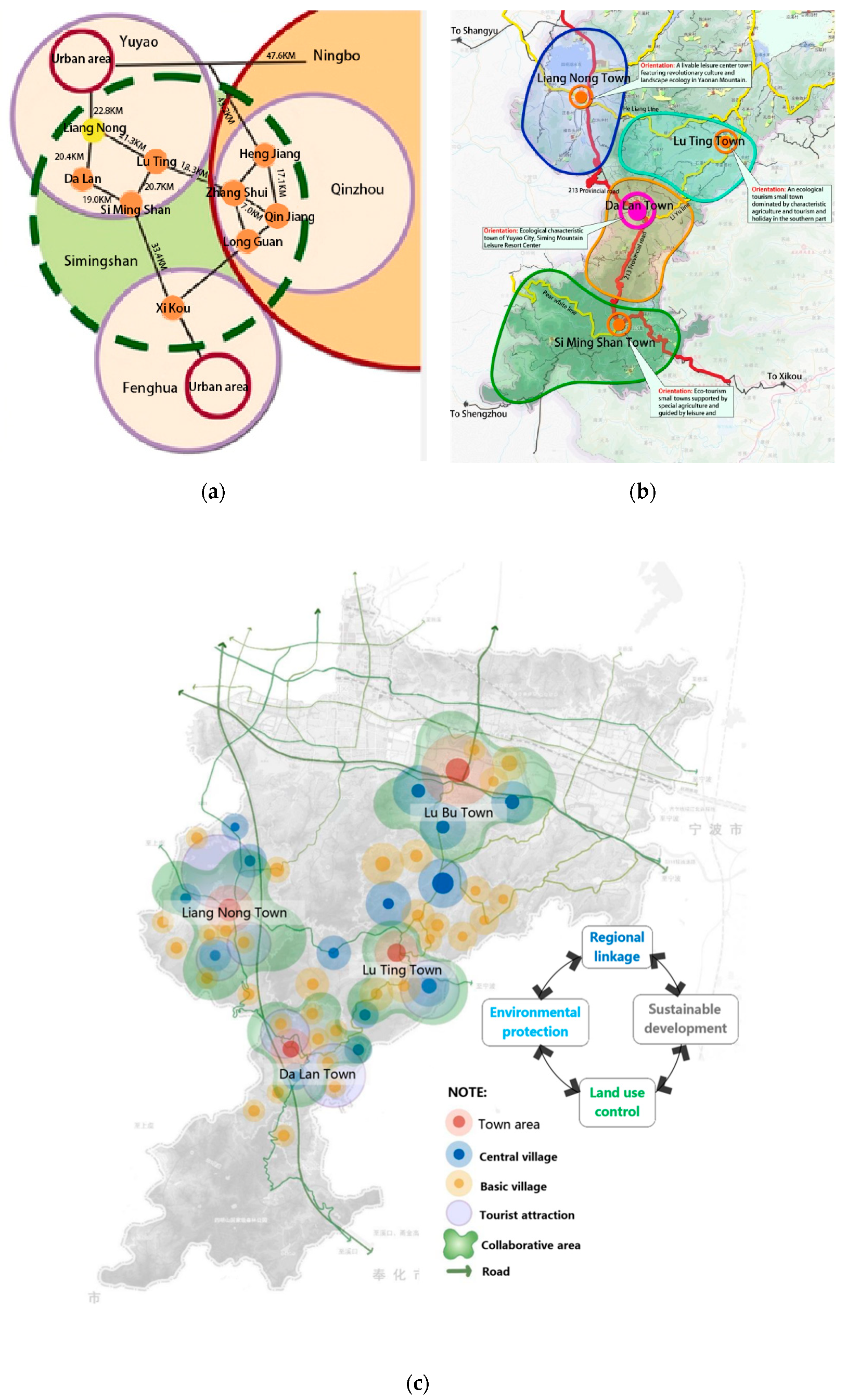
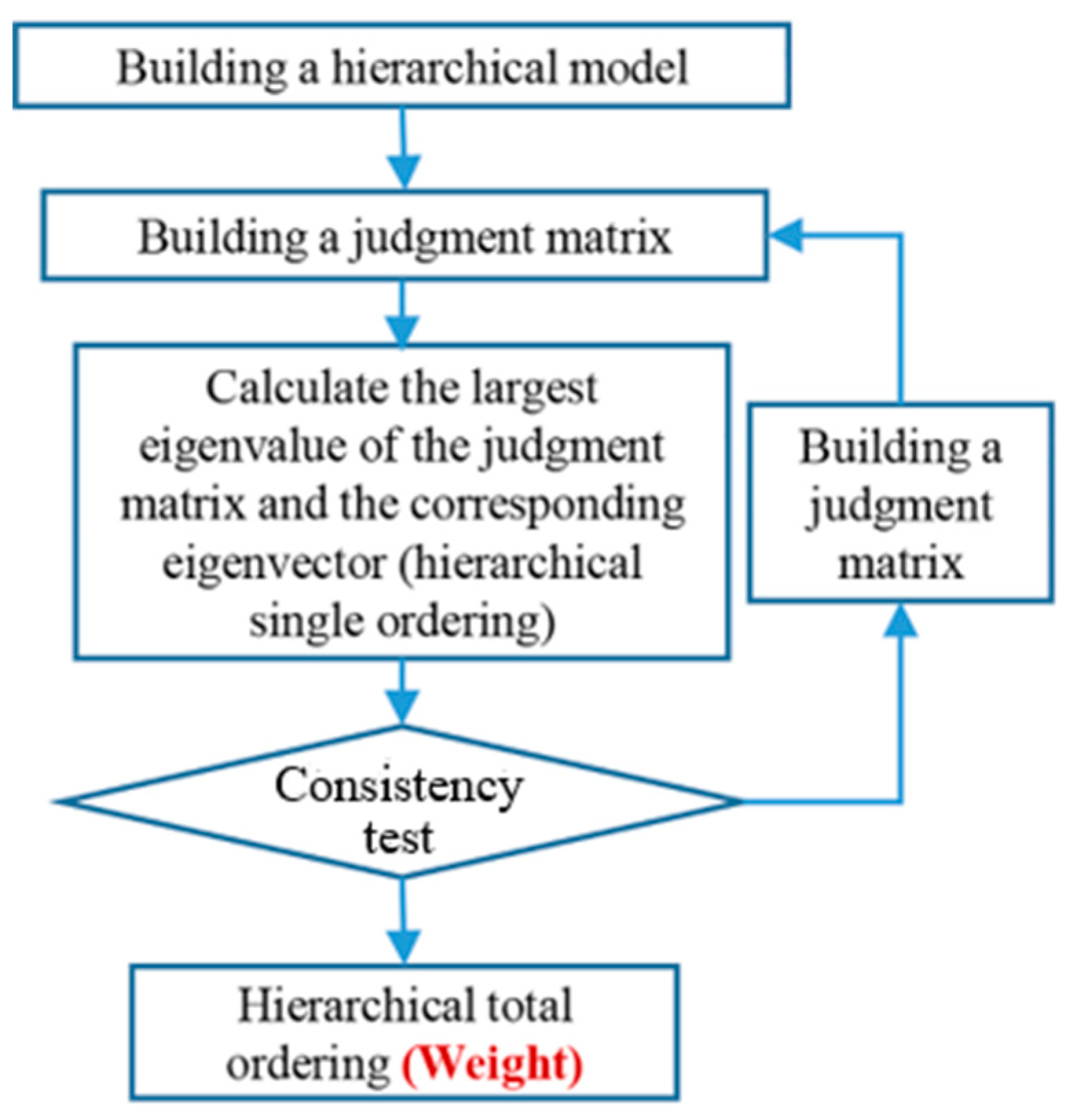


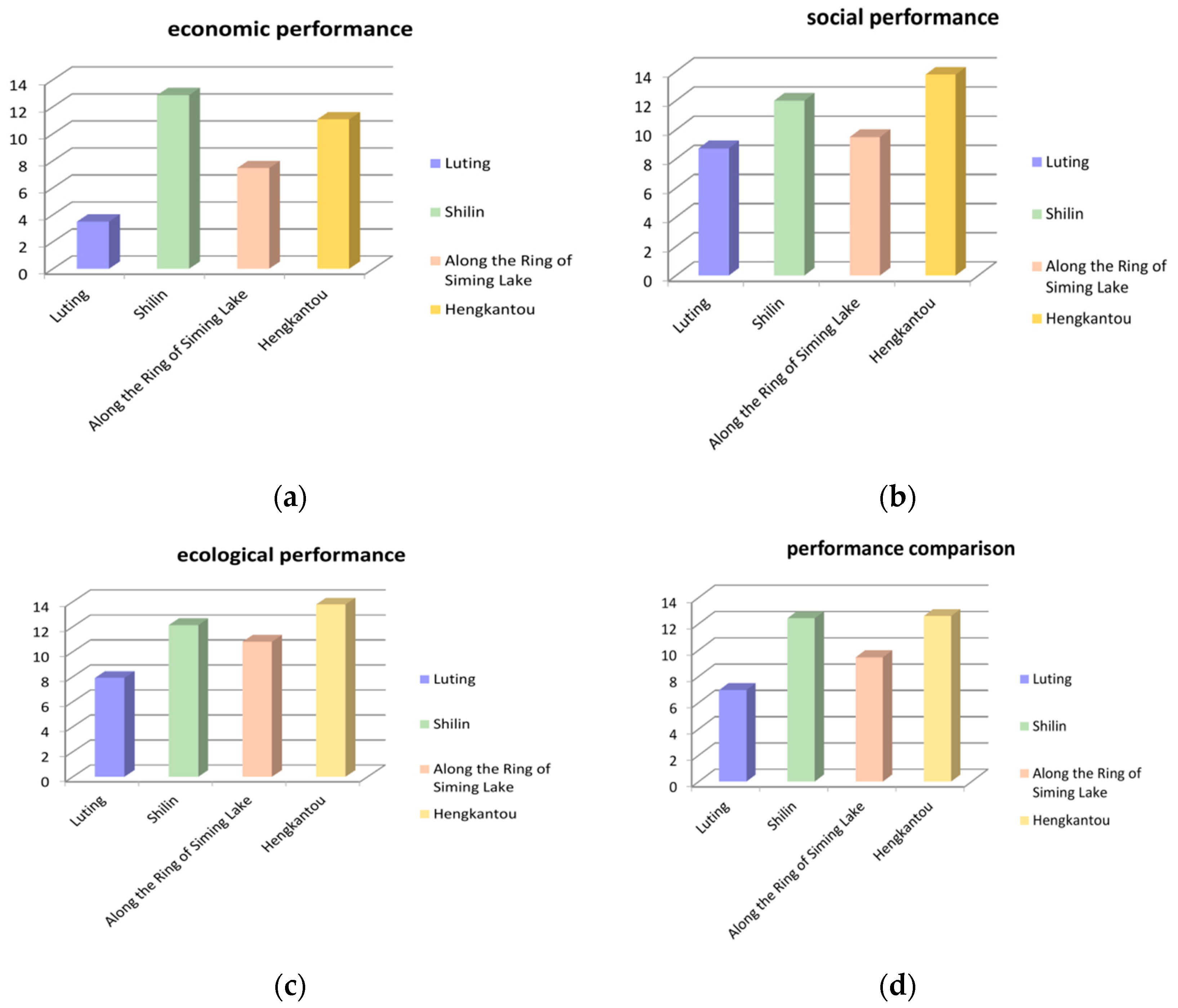

| Name | Year of Announcement | Issued by | Evaluation Object Range | Main Evaluation Content | Main Evaluation Method Used by Indicators | Advantages | Disadvantages |
|---|---|---|---|---|---|---|---|
| Urban master plan implementation assessment method | 2009 | Housing and urban-rural development of the People’s Republic of China | City, built- town area | Implementation of planning objectives and implementation of mandatory content such as land use, transportation, industry, and environmental protection | 1. Before and after planning data comparison of various indicators. 2. Site field inspection verification | 1. It is a statutory planning assessment and is authoritative. 2. There are many mandatory contents, and the evaluation coverage is wide, including social and economic aspects | 1. Weak cooperation between villages development. |
| Zhejiang Province Small Towns Environmental Comprehensive Improvement Assessment Score | 2016 | Zhejiang Small Town Environmental Comprehensive Improvement Action Leading Group Office | Small towns in Zhejiang Province | External image remediation as the core, including environmental sanitation, urban order, township and town appearance nodes, etc. | Field research, on-site inspection | The evaluation content is rich and fits the town construction, and it is highly targeted to the villages and towns in this research area | Indicators are too targeted to quantify, weak versatility |
| Beautiful rural construction evaluation index | 2018 | State General Administration of the People’s Republic of China for Quality Supervision and Inspection and Quarantine and the National Standards Committee | Beautiful country building | Village construction, ecological environment, economic development, public service content, and software aspects such as facility management, maintenance, funding, staffing, etc. | 1.Evaluation of the report 2. field investigation 3. access to on-site information | 1. Part of the indicators can be quantified and accurate 2. The performance evaluation of rural construction is highly targeted and conforms to the actual situation of rural China | The evaluation of social development performance such as population is weak |
| US “landscape performance” evaluation index | 2010 | Landscape Architecture Foundation | Completed urban park green space | Ecological performance evaluation, including land, water, habitat, carbon, energy and air quality, materials and waste, economy [16] | 1. Information Verification 2. Field investigation | 1. In line with the requirements of the era of sustainable development 2. Has a quantifiable calculation toolbox [17,18] | 1. The calculation toolbox need adaptation for practical use in China 2. The content of the evaluation indicators is too microscopic for the performance of village construction [17,18] |
| First Level | Second Level | Third Level | Remark | Source |
|---|---|---|---|---|
| Economic performance | Industrial economy | Economic strength | Gross regional product and per capita output value | Government statistics |
| Industrial structure | Tertiary industry value and proportion | |||
| Visitor volume | Statistical report | |||
| Resident employment type | General type of employment | Questionnaire | ||
| Parking revenue | Tourism is more suitable | |||
| Social development | Urbanization rate | For small towns evaluation | Government statistics | |
| Aging rate | ||||
| Rural hollowing percentage | ||||
| Population growth rate | ||||
| Space usage | Residential space distribution | Planning implementation level | Satellite image observation and analysis available | |
| Land structure | The proportion of each type of land | Data comparison before and after planning | ||
| Spatial structure | ||||
| Real estate value | Residential sales price | |||
| Rent | ||||
| Job | Number of jobs created | |||
| Tourism consumption | Site rental fee | |||
| Ticket income | ||||
| Sales revenue at the scenic spot | ||||
| Social performance | Public facility | Education | Whether the construction of public facilities is in accordance with the plan, construction level and effectiveness | Government statistics, work report and interview |
| Medical | ||||
| Culture | ||||
| Sport | ||||
| Pension | ||||
| Municipal infrastructure | Traffic | Whether the construction of public facilities is in accordance with the plan, construction level and effectiveness | ||
| Water supply | ||||
| Drainage | ||||
| Electric power | ||||
| Telecommunications | ||||
| Related policy | Public participation | Awareness of government-related policies | ||
| Satisfaction | Residents’ satisfaction with government-related policies | |||
| Safe society | Flood | |||
| Fire | ||||
| Earthquake | ||||
| Culture | Ancient tree protection | |||
| Historical and cultural heritage protection | Whether the construction caused a breach of the ring; whether there is protection and repair work; whether it is integrated with tourism development | Site research and interviews | ||
| Cultural activity | What specific cultural practices and cultural activities are carried out | |||
| Ecological performance | Ecosystem | Urban air particulate reduction | ||
| Water source protection | Whether to protect according to the planning expectations, and the protection status quo | Government statistics and interviews | ||
| Agricultural and forestry protection | ||||
| Water quality | Main rivers and lakes | Data comparison | ||
| Rainwater and sewage construction | Related construction situation | Main landscape node site survey | ||
| Rainwater management | ||||
| Enterprise pollution transformation | Industrial and aquaculture pollution treatment situation | Site research and interviews | ||
| Environmentally friendly materials use | Whether it is implemented according to design | Main landscape node site survey | ||
| Landscape environment | Green space system | Planning and construction | Government work report and interview | |
| Green coverage | ||||
| Per capita greening rate | Implementation rate | Government statistics | ||
| Main landscape node construction style | Construction status of the consistency with the planning | Photo comparison and interviews to understand the construction situation | ||
| Street environment | Health status, interface appearance, vehicle order | |||
| Community environment | Sanitary facilities situation | |||
| Landscape satisfaction | Landscape view | Research |
 Village and town planning implementation assessment other content factors;
Village and town planning implementation assessment other content factors;  The Beautiful Rural Construction evaluation index factors;
The Beautiful Rural Construction evaluation index factors;  Screening of American LP evaluation index factors;
Screening of American LP evaluation index factors;  Zhejiang Province Small Towns Environmental Comprehensive Improvement Action Township Assessment Score factors.
Zhejiang Province Small Towns Environmental Comprehensive Improvement Action Township Assessment Score factors.| Post-Construction Evaluation Indicator System for Coordinated Development of Rural Communities & Small-Towns Based on “Ecological Priority and All-Area Integrated Development” | Landscape Construction Planning (Shilin Village–2014) | Analytic Hierarchy Process and Fuzzy Comprehensive Evaluation | ||||||||||||||
|---|---|---|---|---|---|---|---|---|---|---|---|---|---|---|---|---|
| First Level | Second Level | Third Level | Remark | Source | Pre-Planning Status | Planning Objectives | Verifying Status | Weights | Classification | Score | ||||||
| Best (2) | Better (1) | General (0) | Bad (−1) | Worse (−2) | ||||||||||||
| Economic performance | Industrial Economy | Visitors volume | Government statistics | Total number of tourists in 2015 was 500,000, visitors per day were 0.15 million/day. | The planned average daily tourist volume is 0.23 million | •After the planning, the number of tourists has increased | 0.053 | 6 | 2 | 1 | 0 | 0 | 14 | 15.0 | 12.88 | |
| Parking revenue | Mainly for tourists parking | ○ | • | •Increased parking lot revenue after planning | 0.053 | 7 | 2 | 0 | 0 | 0 | 16 | |||||
| Real estate value | Residential sales price | ○ | ○ | • | 0.053 | 5 | 3 | 1 | 0 | 0 | 13 | 12.0 | ||||
| House rental fee | •Accommodation was two-star level | • | •After the planning, the price of accommodation is raised. | 0.053 | 3 | 5 | 1 | 0 | 0 | 11 | ||||||
| Job | Number of jobs created | • The service industry level was low | •Increasing tourism services; Improving the services quality | •Tourism service projects have increased and the number of jobs has increased | 0.053 | 4 | 5 | 0 | 0 | 0 | 13 | 13.0 | ||||
| Tourism consumption | Site rental fee | ○ | • | •Increased rental revenue after planning | 0.053 | 3 | 5 | 1 | 0 | 0 | 11 | 12.0 | ||||
| Ticket revenue | •Ticket revenue is relatively stable, high income in summer and autumn season | ○ | •Increased whole year ticket sales after planning | 0.053 | 6 | 1 | 2 | 0 | 0 | 13 | ||||||
| Internal consumption within scenic areas | •23 Farmhouses, 1980 dining places, 91 beds homestay of general consumption level | Plan to increase 560 beds, improvement of dining grade | •The number of homestays has increased, and the level of dining has not improved much. | 0.053 | 4 | 4 | 1 | 0 | 0 | 12 | ||||||
| Social performance | Cultural style | Ancient tree protection | ○ | 16 ancient trees protection planning | Key ancient tree brand protection | 0.053 | 4 | 5 | 0 | 0 | 0 | 13 | 12.0 | 12.00 | ||
| Historical and cultural heritage protection | Protection and repair work situation; tourism development integration situation | Site research and interviews | Historical and cultural buildings were generally protected; the overall construction quality was poor | To repair and protect historical and cultural buildings, to improve the surrounding environment | Repairing and improvement effect is obvious, the surrounding environment has improved | 0.053 | 5 | 2 | 2 | 0 | 0 | 12 | ||||
| Cultural activity | Types of specific cultural practices and activities | Existing “Shen Clan” Sacrifice Culture, the Persimmon Festival | Diversifying cultural and folk activities | Implementation of the red cultural activities | 0.053 | 5 | 1 | 3 | 0 | 0 | 11 | |||||
| Ecological performance | Ecosystem | Water quality | Main rivers and lakes | Data comparison | •Most of the water resources were type II water | Dredging the river to improve the quality of the water environment | •Water quality has improved | 0.053 | 5 | 3 | 1 | 0 | 0 | 13 | 12.0 | 12.13 |
| Rainwater and sewage construction | Related construction situation | Main landscape node site survey | Frequent flood disasters | Dredging the river channel to improve flood discharge capacity; greening on both sides of the mountain river channel to enhance water storage capacity; widening the river section to consolidate and strengthen flood control capacity | The implementation of rainwater management construction is better, no stormwater disaster occurs during the year. | 0.053 | 4 | 4 | 1 | 0 | 0 | 12 | ||||
| Environmentally friendly materials usage | Whether it is implemented by design | Main landscape node site survey | Constructed with mostly low environmentally friendly materials | To use native stone for building walls, advocating native plants usage | Partially remodeled buildings use native stone, and more native plants are used. | 0.053 | 5 | 2 | 1 | 1 | 0 | 11 | ||||
| Landscape environment | Green coverage | Village green coverage was high | Greening along the road line to enrich the plant landscape | The planning area is good in richness and variety. | 0.053 | 4 | 2 | 2 | 1 | 0 | 9 | 12.2 | ||||
| Main landscape node construction style | Construction status, consistency with planning | Photo comparison and interviews to verify the construction situation | Node landscape was poor | Transforming and upgrading important landscape nodes, featuring the cultural context | The implementation is basically consistent with the plan, and the effect is better. | 0.053 | 2 | 6 | 1 | 0 | 0 | 10 | ||||
| Street environment | Cleanness status, Street scape, parking order | Monotonous view, rough street furniture, parking chaos | Improving the street environment to create a clean and tidy street, to build a new garage for village vehicles | The street environment is upgraded to a higher level, the street facilities have been upgraded, the new garage has a high utilization, village parking more orderly. | 0.053 | 7 | 2 | 0 | 0 | 0 | 16 | |||||
| Community environment | Sanitary facilities situation, and landscape view | Traditional building structures were aging, the public facilities were not perfect | Demolition and repair of certain buildings | The overall community environment has been improved | 0.053 | 5 | 4 | 0 | 0 | 0 | 14 | |||||
| Landscape satisfaction | Research | ○ | High satisfaction | •Higher satisfaction | 0.053 | 4 | 4 | 1 | 0 | 0 | 12 | |||||
| 1 | 12.421 | |||||||||||||||
 Village and town planning implementation assessment other content factors;
Village and town planning implementation assessment other content factors;  The Beautiful Rural Construction evaluation index factors;
The Beautiful Rural Construction evaluation index factors;  Screening of American LP evaluation index factors;
Screening of American LP evaluation index factors;  Zhejiang Province Small Towns Environmental Comprehensive Improvement Action Township Assessment Score factors.
Zhejiang Province Small Towns Environmental Comprehensive Improvement Action Township Assessment Score factors.| Post-Construction Evaluation Indicator System for Coordinated Development of Rural Communities and Small Towns Based on “Ecological Priority and All-Area Integrated Development”(Transportation Infrastructure and Leisure Facilities) | Concept Planning of Tourism Development in Dalan Town (2015) | Analytic Hierarchy Process and Fuzzy Comprehensive Evaluation | |||||||||||||
|---|---|---|---|---|---|---|---|---|---|---|---|---|---|---|---|
| First Level | Second Level | Third Level | Source | Remark | Analysis of the Status Quo before Planning and Construction | Verifying After Planning and Construction | Weights | Classification | Score | ||||||
| Best (2) | Better (1) | General (0) | Bad (−1) | Worse (−2) | |||||||||||
| Economic performance | Industry | Visitors volume | Statistical report | Catered more than 6.7 million visitors in 2014 | Visitors increased | 0.10 | 3 | 4 | 2 | 0 | 0 | 10 | 7.67 | 18.67 | |
| Resident employment type | Questionnaire | General type of employment | • | The number of employed people in tertiary employment has increased year by year | 0.10 | 3 | 3 | 3 | 0 | 0 | 9 | ||||
| Parking revenue | Mostly for tourists parking | ○ | Revenue largely increased in the peak season | 0.10 | 0 | 5 | 3 | 1 | 0 | 4 | |||||
| Real estate value | House rental fee | • | Rental fee significantly Increased | 0.10 | 1 | 2 | 4 | 2 | 0 | 2 | 2.00 | ||||
| Jobs | Number of jobs created | ○ | Tourism packages such as boutique hotels and hotels have greatly boosted employment in the tourism industry | 0.10 | 2 | 3 | 4 | 0 | 0 | 7 | 7.00 | ||||
| Tourism consumption | Site rental fee | • | • | 0.10 | 0 | 3 | 5 | 1 | 0 | 2 | 2.00 | ||||
| Social performance | Municipal infrastructure | Traffic | Facilities Construction accordance with the plan, and construction effectiveness | One existing gas station; main road frame consist of two road lines, linking various tourist attractions and administrative villages | One tourist distribution center, three bicycle stations, 12 scenic spots VR showcase pavilions are added; over 10 bike riding trails, car driving lines, and walking trails are planted. | 0.10 | 5 | 3 | 1 | 0 | 0 | 13 | 13.00 | 13.00 | |
| Ecological performance | Ecosystem | Environmental friendly materials usage | Main landscape node site survey | Whether it is implemented according to design | Villages roads were mainly old stone pavements | Using local materials such as stones and permeable grass plants for landscape implementation | 0.10 | 2 | 4 | 3 | 0 | 0 | 8 | 8.00 | 19.00 |
| Landscape environment | Main landscape node construction style | Photo comparison and interviews to verify the construction situation | Construction status, consistency with planning | The landscape features along the main line were good | Key scenery and vista landscape nodes are further more improved | 0.10 | 4 | 3 | 2 | 0 | 0 | 11 | 11.00 | ||
| Landscape satisfaction | Research | General | Better | 0.10 | 3 | 5 | 1 | 0 | 0 | 11 | |||||
| 1 | 16.89 | ||||||||||||||
 Village and town planning implementation assessment other content factors;
Village and town planning implementation assessment other content factors;  The Beautiful Rural Construction evaluation index factors;
The Beautiful Rural Construction evaluation index factors;  Screening of American LP evaluation index factors;
Screening of American LP evaluation index factors;  Zhejiang Province Small Towns Environmental Comprehensive Improvement Action Township Assessment Score factors. Source: “Dalan Town Tourism Development Concept Plan” prepared by Shanghai Xilian Urban Planning Architectural Design Co., Ltd.; “Dalan Town Master Plan (2011–2030) Partial Revision” (2016) prepared by Zhejiang Jianyuan Architectural Planning and Design Institute.
Zhejiang Province Small Towns Environmental Comprehensive Improvement Action Township Assessment Score factors. Source: “Dalan Town Tourism Development Concept Plan” prepared by Shanghai Xilian Urban Planning Architectural Design Co., Ltd.; “Dalan Town Master Plan (2011–2030) Partial Revision” (2016) prepared by Zhejiang Jianyuan Architectural Planning and Design Institute. | Luting Town | Shilin Village | Along the Ring of Siming Lake | Hengkantou Village | |
|---|---|---|---|---|
| Economic performance | 3.50 | 12.86 | 7.46 | 11.07 |
| Social performance | 8.73 | 12.00 | 9.50 | 13.78 |
| Ecological performance | 7.91 | 12.13 | 10.80 | 13.78 |
| Comprehensive performance | 6.96 | 12.42 | 9.45 | 12.59 |
| Evaluation Index System After Comprehensive Planning | Study Sample Typical Case Index Selection | ||||
|---|---|---|---|---|---|
| Level 1 | Level 2 | Project Type | |||
| Village Planning (Hengkantou Village) In 2013 | Landscape Planning (Shilin Village) in 2014 | Tourism Planning (Along the Ring of Siming Lake) in 2016 | Comprehensive Improvement Project of Small Towns (Luting Town) In 2017 | ||
| Economic performance | Industrial economy | 12.8 | 15 | 8.5 | 1.5 |
| Social development | 9 | / | / | / | |
| Space usage | 10.3 | / | 10 | 3 | |
| Real estate value | 11 | 12 | 7.5 | 4 | |
| Jobs | 12 | 13 | 10 | 6 | |
| Tourism consumption | 10 | 12 | 6.7 | 5 | |
| Social performance | Public service facilities | 13.8 | / | 8 | 8.8 |
| Municipal infrastructure | 13.8 | / | 12 | 8 | |
| Relevant policy | 13 | / | 7 | 5 | |
| The social security | 10.7 | / | 11 | 4 | |
| Cultural landscape | 14.3 | 12 | 11.3 | 10 | |
| Ecological performance | The ecological environment | 10.4 | 12 | 11.3 | 8.4 |
| Landscape environment | 12.8 | 12.2 | 9 | 7 | |
© 2019 by the authors. Licensee MDPI, Basel, Switzerland. This article is an open access article distributed under the terms and conditions of the Creative Commons Attribution (CC BY) license (http://creativecommons.org/licenses/by/4.0/).
Share and Cite
Zhao, T.; Zhao, Y.; Li, M.-H. Landscape Performance for Coordinated Development of Rural Communities & Small-Towns Based on “Ecological Priority and All-Area Integrated Development”: Six Case Studies in East China’s Zhejiang Province. Sustainability 2019, 11, 4096. https://doi.org/10.3390/su11154096
Zhao T, Zhao Y, Li M-H. Landscape Performance for Coordinated Development of Rural Communities & Small-Towns Based on “Ecological Priority and All-Area Integrated Development”: Six Case Studies in East China’s Zhejiang Province. Sustainability. 2019; 11(15):4096. https://doi.org/10.3390/su11154096
Chicago/Turabian StyleZhao, Tiezheng, Yang Zhao, and Ming-Han Li. 2019. "Landscape Performance for Coordinated Development of Rural Communities & Small-Towns Based on “Ecological Priority and All-Area Integrated Development”: Six Case Studies in East China’s Zhejiang Province" Sustainability 11, no. 15: 4096. https://doi.org/10.3390/su11154096
APA StyleZhao, T., Zhao, Y., & Li, M.-H. (2019). Landscape Performance for Coordinated Development of Rural Communities & Small-Towns Based on “Ecological Priority and All-Area Integrated Development”: Six Case Studies in East China’s Zhejiang Province. Sustainability, 11(15), 4096. https://doi.org/10.3390/su11154096





